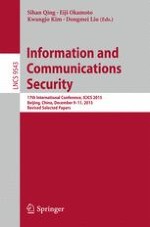2016 | Buch
Information and Communications Security
17th International Conference, ICICS 2015, Beijing, China, December 9–11, 2015, Revised Selected Papers
herausgegeben von: Sihan Qing, Eiji Okamoto, Kwangjo Kim, Dongmei Liu
Verlag: Springer International Publishing
Buchreihe : Lecture Notes in Computer Science
